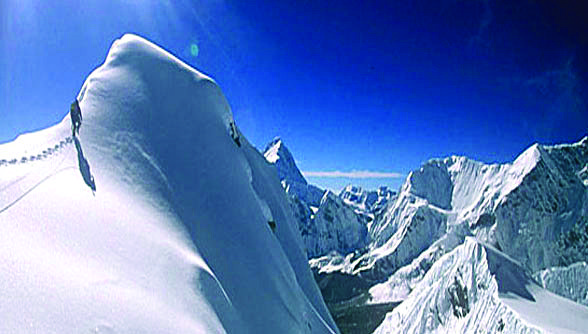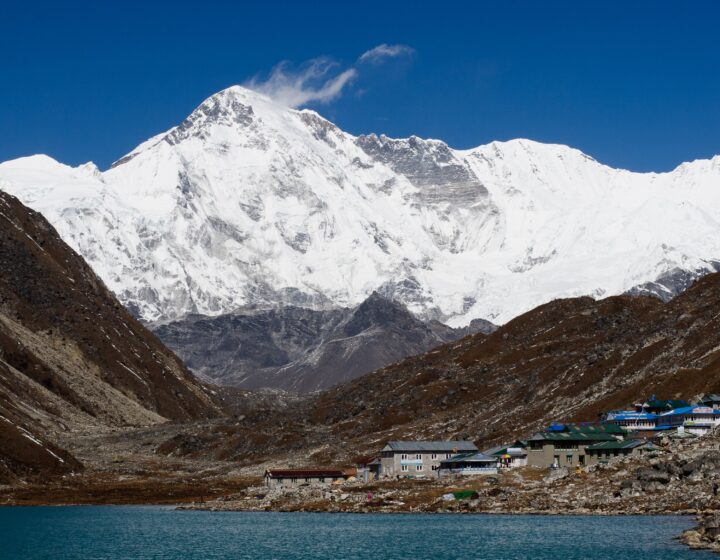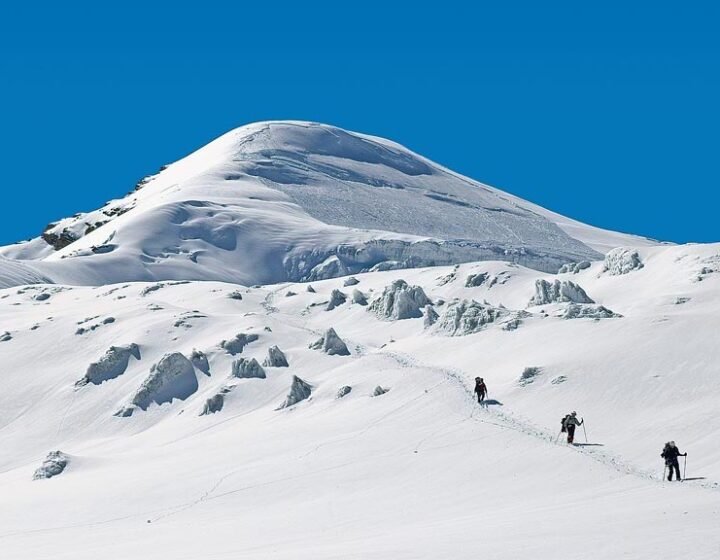- Details
Detailed itinerary
Itinerary- Tour Includes/Excludes
- Useful Info
- Trip Map
- FAQ
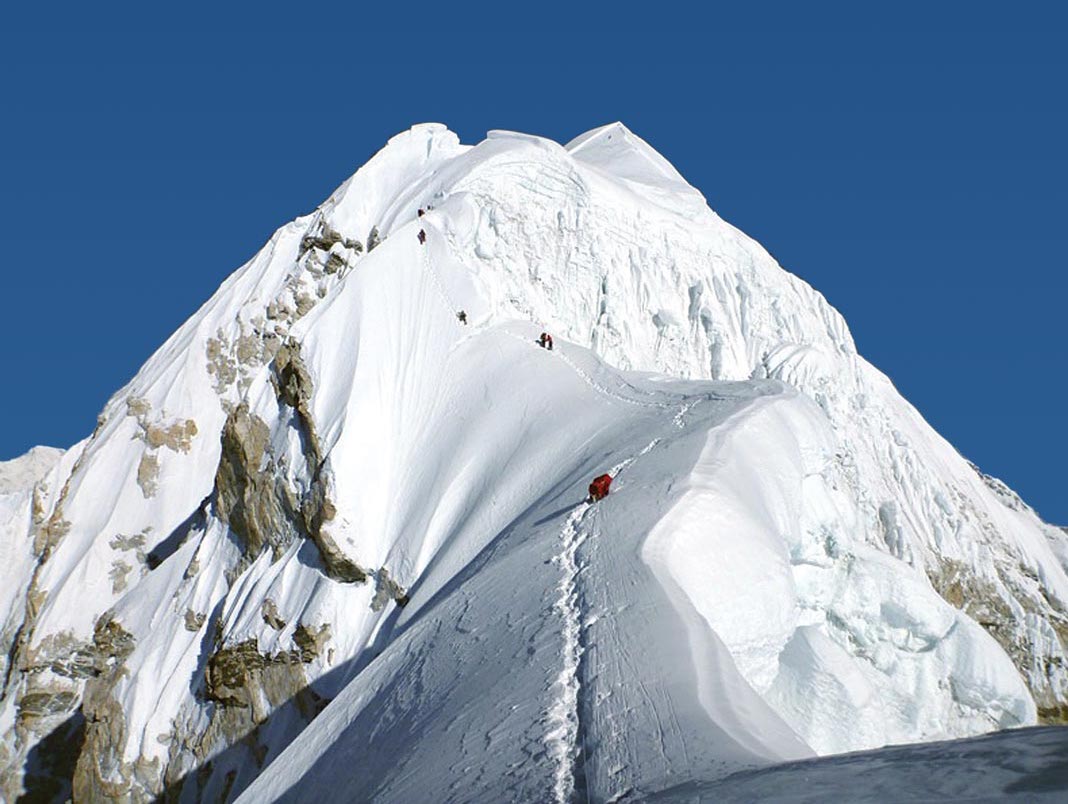
Trip overview
The Baruntse Expedition is a thrilling journey for climbers who want to reach the summit of a 7000-meter peak in a remote region of Nepal. It provides a fantastically gratifying ascent among the world’s highest peaks. The 7129-meter-high Baruntse Peak is located just south of the semi-circle of beautiful mountains. On one hand, there’s Everest, Lhotse, and Nuptse, while on the other hand, there’s Makalu. The route to Baruntse summit passes through the beautiful natural setting of the Hinku valley and the renowned Mera La of Nepal’s remote valleys. Despite being exciting and hard, this climbing adventure is regarded as one of the simpler ascents of a 7000+ m peak. Notably, it has a high success rate of reaching the summit and returning safely. Everything from base camp to the western part, with its massive glacial plateau, will make your ascent both tough and inspiring.
Despite being lower in elevation than nearby mountains, you will be at the heart of the powerful Himalayan peaks. The iconic Lhotse south face is clearly visible in front of you, as it is the beautiful Makalu west pillar. Participating in Baruntse climbing necessitates the use of many of the many abilities required for climbing any 8000-meter peak. Without a doubt, it provides the best preparation for peak climbing before going on any of the Himalayan 8000-meter peak adventures. The South-East Ridge of Baruntse demands commitment and significant effort to succeed in the final push to the summit, with steep stretches of ice at 50 degrees and a noticeable ice cliff at around 7000 meters.
Climbing Route of Climbing, Base Camp with Safety Backup
This Baruntse Expedition program has been meticulously planned to ensure that all expedition members receive enough acclimatization. Furthermore, considerable stamina and expertise are required to deal with the necessary climbing to reach the peak. In addition, in base camp, we organize a unique refreshment climbing training session where all expedition members can train and improve their skills in order to climb safely and successfully. We set up our base camp at 5300 meters, where our expedition cooks prepare all of the delicious meals. Our expert climbers established higher camps at 6400 and 6800 meters. We install ropes to ensure the summit push is safe and secure. As a safety backup, we have medically certified guides, a full medical kit, an oxygen cylinder, a portable altitude chamber, a satellite phone, and a walkie-talkie.
Highlights:
- The ascent to the peak of Baruntse (7129m)
- The Himalayan foothills
- The world’s most majestic mountain massifs
- Mt. Everest (8,848m), Mt. Lhotse (8,516m), Mt. Makalu (8,481m), Mt. Cho Oyu (8,201m), and others.
- Nepal’s highest trekking peak, Mera Peak (6,476m),
- A cultural overview of the Sherpa communities’ villages
- Incredible glaciers, mountain passes, and water streams.
Itinerary
Day 1: Arrival in KathmanduOne of our staff members will greet you as you leave the airport terminal while holding a placard bearing your name, Annapurna Foothills Treks & Expedition. You will now be driven in our private tourist van to your accommodation. Once you arrive at the hotel, they will greet you as well, and you may then unwind in your room.
Our company's managing director will meet you at the hotel and provide you with further details about the adventure. Your travel costs must be paid in full before we go on climbing. We will complete the paperwork for your trip permit and perform one last inspection of your climbing gear. You will have the opportunity to purchase any additional trekking supplies you might need. Other sightseeing trips are available in the Kathmandu Valley.
It takes about 40 minutes to fly early in the morning to Lukla's Tenzing-Hillary Airport. We arrive in a valley encircled by lofty mountain peaks. We will immediately start the hike after our climbing crew meets us at the airport. This route, which starts in Lukla and descends to Paiya, is beneficial for acclimatization. Through rhododendron forests, the trail descends to the traditional settlements of Surke and Pakhepani through woodlands. You'll also get a fantastic view of Knogde Ri, Khatang, Tang Ragi Tu, and other peaks that are over 7000 meters high from Paiya.
From Paiya, there is a brief dip to a wooden bridge, which we must cross before beginning the steep, treacherous ascent to the 3145m-high Kari La Pass. The bamboo and rhododendron forest is traversed by a little route. The Dudhkoshi River valley below and the Dudh Kund Himal in the distance will make for a stunning scene. A farming and commerce village is Pangoma.
The rough path descends to a forest of rhododendrons. As we traverse hills and peaks, mani walls serve as trail markers. We pass through pine and rhododendron forests with multiple switchbacks and eventually descend sharply to Sibuche.
Today's trail begins sloping northward and features numerous climbs and descents through a rhododendron and bamboo forest. We frequently cross the crystal-clear Hinku (Inkhu) Khola on a suspension bridge, where it's likely that we'll encounter some wildlife, including sloth bears, wild cats, and a variety of birds.
It begins with a hike through bamboo and pine forests on winding trails. We love the vista of Mera Peak in front of us as the Hinku Valley opens up in front of us as we continue to follow the river. We will have lunch at one of the few teahouses that are located outside of Tashing Dingma.
Ascending gradually today, we follow the Hinku River. Mera Peak and other white giants will be all around us as we travel the trek. Pastures are located on the ridge above the river. There is an old monastery in the summer herder community of Gondishung. As we get closer to the snow line, the number of trees decreases. We will reach the summer grazing area of Tangnak.
To reach the termini of the Hinku Nup and Shar Glaciers, the trail ascends through moraines before gaining altitude more sharply to reach Khare. The path we'll take to Mera Peak is clearly visible from a hilltop above Khare.
We spent the day at Khare exploring and honing our climbing skills in order to acclimatize. We can hike to Mera La and back if we are in good health and feel strong enough.
We hike to the glacier for three hours through a trail that is littered with boulders. Mera La is reached after a brief ascent to a glacial plateau. You can see amazing views after descending around 100 meters toward the Honggu side of the pass. We set up our base camp on the stony moraine.
We ascend the treacherous slope to Mera La, then climb the north flank's rocky protrusion to a rocky outcropping where we establish high camp. The views of Mount Everest, Makalu, Kanchanjunga, Cho Oyu, and the south faces of Lotshe, Nuptse, Chamlang, and Baruntse are all beautiful from High Camp. The majority of the summit route is also visible.
We begin our ascent in the mountains before dawn because it often takes 5 to 6 hours. Together, we put on our ropes and crampons for the ascent to the summit. If there has been recent snowfall, we will need to exercise caution because there are several crevasses. The summit is reached after a quick ascent of an ice wall and is amply rewarded with breathtaking views of Cho Oyu (8201m), Lhotse (8516m), Everest (8848m), Makalu (8463m), Pumori (7161m), Lobuche (6145m), and many other peaks. We have a little abseil before the exhausting descent down to high camp after reaching the peak and taking in the stunning vistas of the Himalaya. Before returning to our camp in the Hinku Valley in Kongma Dingma, we will take a 45-minute break. It's been a long day, but it's been worthwhile.
There is no assurance that the forecasted peak day will be pleasant. This extra day provides some flexibility in case we are unable to reach Mera Peak on the scheduled day owing to bad weather or for any other reason, such as someone in the team experiencing problems with altitude.
Following the bank of the Hongu river, we continue ascending the breathtaking high-altitude valley. Lhotse and the Everest group are visible beyond the Amphu Labtsa, while Ama Dablam is visible to the left of it. From the campsite, we get a wonderful view of Amphu Labtsa, which is encircled by stunning mountains and where we spend the night in a tent.
We continue on the trail in front of unusual lakes and big mountains. As the trail got closer to Baruntse base camp, it became rough with loose rocks. Base camp is in the ideal location, close to a glacial lake and looking out toward the majestic Mount Baruntse.
Allow ten days for the duration of the climb. Before advancing toward our summit, we will make one rotational ascent to Camp II.
The trail is a little challenging when we leave Baruntse base camp till we reach the trail directly from Seto Pokhari. The depth beneath the Amphu Labtsu is approximately 5,500m. Our Sherpa staff prepares the way over the pass while we have a leisurely day and spend the night in a tent.
From Labsta Base Camp to Chhukung (4710m).
A glacier and beautiful ice flutings and formations are part of the approach to the pass, which initially doesn't pose any significant challenges. But the pass is unquestionably not a straightforward climb up a hill.
we travel down the Khumbu valley from Chhukung. Before moving on to Namche, we descend to the Phunki Tenga bridge over the Dudh Kosi, where there are water-powered prayer wheels.
We sprint down the sidewalk in Jorsale toward the Sagarmatha National Park gate, buoyed by all of our new red blood cells. Later, the footpath from Lukla takes us back to the Gumila, Phakdingma, and Choplung villages that we first saw two weeks earlier. The tall mountains vanish behind the hills. This final night in the mountains in Lukla is the perfect time for a farewell celebration with your sherpa guides and porters, as well as a chance to try some change, learn some Nepali and Sherpa dances, and reflect on unforgettable trekking adventures. The crew is expecting some valuable and well-deserved tips.
From Lukla airport, you take a flight to Kathmandu, which takes around 30 minutes to reach. After reaching Kathmandu, you will be sent to your hotel and have a warm dinner at the lodge.
After breakfast, there will be free time for solo activities like souvenir shopping.
On the last day, our agent will drop you at the international airport with all your belonging.
Included
- According to your arrival date, airport transportation
- Kathmandu's standard hotels are available on a B/B basis.
- Kathmandu: airfare from Lukla to Kathmandu according to the excursion schedule.
- Those scaling Baruntse with a Sherpa (01 Sherpa: 02 climbers’ ratio)
- Group climbing supplies for the Baruntse expedition, including rope and ice bars.
- Permit for climbing the Baruntse expedition peak and any applicable taxes.
- Fees for the expedition's national component and conservation permit.
- Full-board, high-altitude meals are provided for the Baruntse Liaison Officer for the hike to base camp and the ascent of the mountain, along with payment for all of his other expenses.
- With their gear, daily pay, meals, and insurance, the support crew, porters, and expedition manager are included.
- Every piece of camping equipment, including base camp tents, dining tents with tables and chairs, kitchen tents, and restroom tents,
- High-altitude tents from Mountain Hardware were used on the Baruntse trip.
Not Included
- High-risk personal and medical insurance
- Entrance visa costs for Nepal
- In Kathmandu, the main meal (three meal per day)
- Personal gear and climbing equipment.
- Flight travel internationally and airport fees.
- Climbing Bonuses, gratuities, and personal costs
- Climbing Bonuses, gratuities, and personal costs
Useful Info
- For increased stability and fitness level, cardio exercises appear to be a wonderful choice for Baruntse Expedition trekkers.
- Keep a buffer day for uncertain events.
- Inquire with your agent if you want any suggestions for your gear, date, or other modes of transportation.
- Bring light foods like muesli, chocolates, chips, and almonds with you to balance your blood sugar and energy levels.
- To increase your metabolism and stay hydrated, drink lots of water.
- should be in sufficient physical condition to make brief ascents and descents.
- Slow down and keep your cool when hiking.
- Follow the guidelines given by the tour guides to learn more about the area.
- Follow all rules and regulations to ensure a successful expedition.
- Try to limit your use of alcohol, while some frequent drinkers may be allowed a few drinks to maintain their faculties.
- Maintain good health because conditions like altitude sickness, vertigo, avalanches, and asthma can arise.
- Take note of the seasons that offer the most unique experiences.
Trip Map
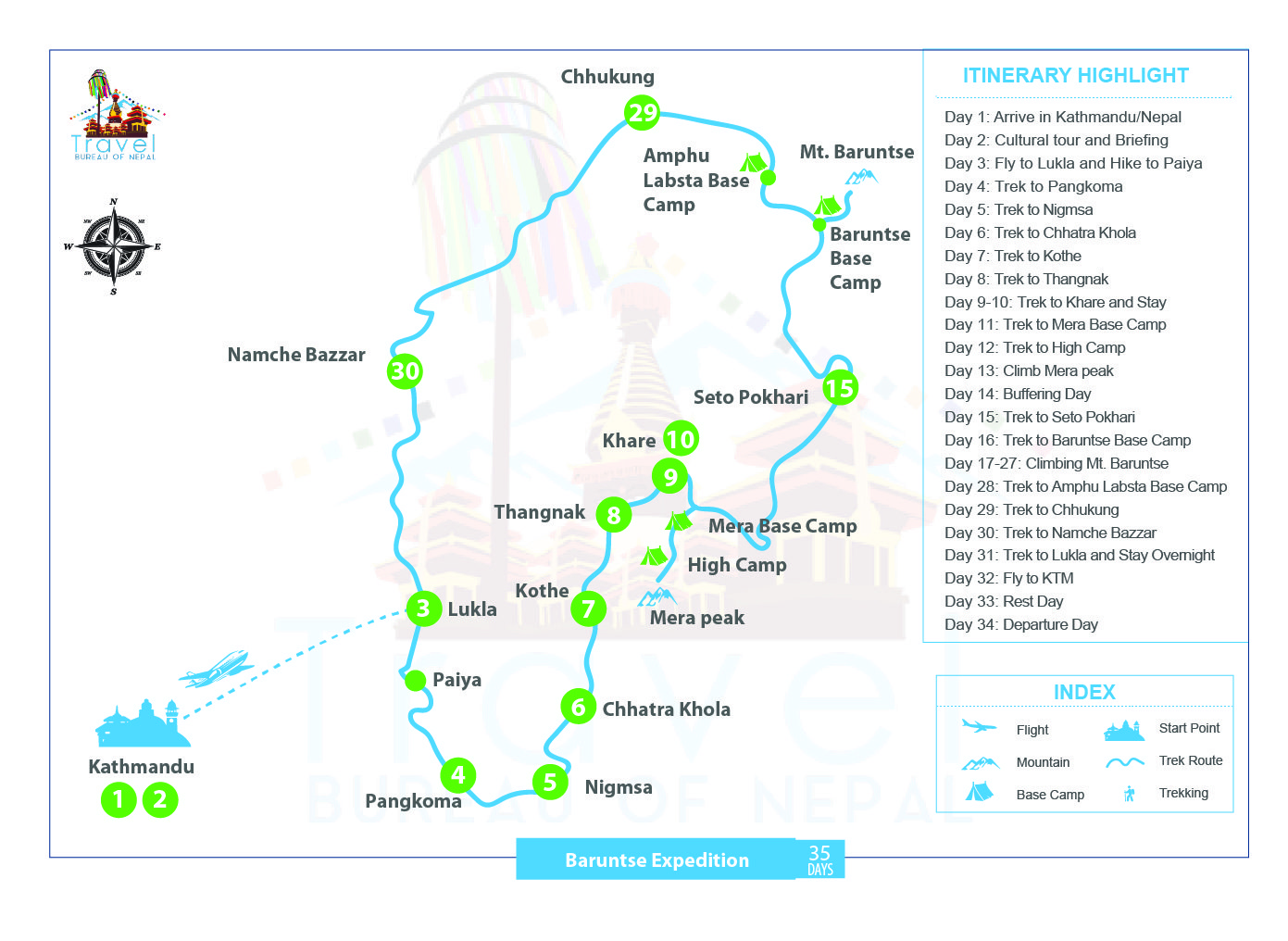
FAQs
-
How difficult it is to climb Baruntse Expedition?
Comparatively speaking, the Baruntse Expedition is more difficult than other Khumbu treks. Trekkers must go ready for a few tough climbs that entail utilizing a fixed rope to navigate glaciers and climb up high slopes.
-
Is altitude sickness an issue while climbing Baruntse Expedition?
People struggle with weakness, tiredness, and shortness of breath when the barometric pressure is low. As a result, these small symptoms must be treated quickly, as they could otherwise result in hypoxemia and a number of additional issues.
-
Best season to climb Baruntse Expedition?
For hikers, the Baruntse Expedition frequently causes problems. The hardest season for climbers who want to ascend the mountains is winter. At higher altitudes, the short weather, which includes heavy snowfall and fierce wind, presents them with ongoing obstacles. Monsoon weather is also unfavorable, with a steady downpour in the lower slopes that makes the trail slick. At the high camp, they will come across snow-covered pathways, chilly temperatures, and strong winds that blur their vision.
-
What do I need to prepare for Baruntse Expedition?
For climbing, you have to be prepared physically, mentally, and also gear-wise. To successfully climb Baruntse, one must be physically fit; otherwise, one cannot reach the summit. Prior to the expedition, they'll need to stay in shape and pick up some technical abilities, like rock climbing. Likewise, you should be mentally aware about the challenges and altitude of Baruntse. Any challenging expedition, even one like climbing Mount Everest, can be made simpler with the correct gear. As a result, Baruntse Expedition Nepal trekkers will need to bring the necessary equipment to make the walk simpler. Instead of haphazardly purchasing trekking equipment

